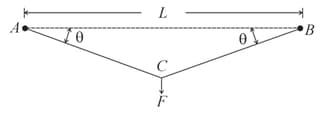EASY
Earn 100
What is significance of Young's modulus of elasticity?
Important Questions on Properties of Solids and Liquids
EASY
For a perfectly rigid body,
MEDIUM
A load of mass is suspended from a steel wire of length and radius in Searle's apparatus experiment. The increase in length produced in the wire is Now the load is fully immersed in a liquid of relative density The relative density of the material of load is The new value of increase in length of the steel wire is:
EASY
Copper of fixed volume is drawn into wire of length . When this wire is subjected to a constant force the extension produced in the wire is Which of the following graph is a straight line?
MEDIUM
The Young's modulus of steel is twice that of brass. Two wires of same length and of same area of cross-section, one of steel and another of brass are suspended from the same roof. If we want the lower ends of the wires to be at the same level, then the weights added to the steel and brass wires must be in the ratio of:
EASY
A rubber cord of density Young's modulus and length is suspended vertically. If the cord extends by a length under its own weight, then is
EASY
A metallic rod breaks when strain produced is . Young's modulus of the material of the rod is . What should be its area of cross-section to support a load of ?
MEDIUM
Young's moduli of two wires and are in the ratio . Wire is long and has radius Wire is long and has radius If the two wires stretch by the same length for a given load, the value of is close to:
MEDIUM
A rubber cord has a cross-sectional area and total unstretched length . It is stretched to and then released to project a particle of mass . The velocity of projection is [Given, Young's modulus of rubber, ]
MEDIUM
A steel rail of length and area of cross section is prevented from expanding along its length while the temperature rises by . If coefficient of linear expansion and Young's modulus of steel are and respectively, the force developed in the rail is approximately:
HARD
A uniformly tapering conical wire is made from a material of Young's modulus and has a normal, unextended length . The radii, at the upper and lower ends of this conical wire, have values and , respectively. The upper end of the wire is fixed to a rigid support and a mass is suspended from its lower end. The equilibrium extended length, of this wire, would equal:
EASY
An object of mass is suspended at the end of a massless wire of length and area of cross-section, A. Young modulus of the material of the wire is . If the mass is pulled down slightly its frequency of oscillation along the vertical direction is :
HARD
A pendulum made of a uniform wire of cross sectional area A has time period T. When an additional mass M is added to its bob, the time period changes to . If the Young's modulus of the material of the wire is , then is equal to:
(gravitational acceleration)
EASY
A wire of length , area of cross section is hanging from a fixed support. The length of the wire changes to when mass is suspended from its free end. The expression for Young’s modulus is:
MEDIUM
Three thin wires of equal length are suspended from the top of a roof. The respective ratio of their area of cross section is and Young's modulii is then the ratio of their weights to be attached at the other ends to obtain same elongation in them is
EASY
The Young's modulus of a perfectly rigid body is
HARD
String of unstretched length is stretched by applying a force at the mid-point such that the segments and make an angle with as shown in the figure. The string may be considered as an elastic element with a force to elongation ratio . The force is given by

MEDIUM
A copper wire of cross-sectional area is under a tension of . Find the percentage change in the cross-sectional area (Young's modulus of copper and Poisson ratio )
HARD
A thin long rod has a radius of . A force of is applied at one end to determine its Young's modulus. Assume that the force is exactly known. If the least count in the measurement of all lengths is , which of the following statements is false?
MEDIUM
A metal rod of length and cross-sectional area is heated through . What is the force required to prevent the expansion of the rod lengthwise?
= Young's modulus of the material of rod, coefficient of linear expansion
HARD
A steel wire of diameter and Young's modulus carries a load of mass . The length of the wire with the load is . A vernier scale with divisions is attached to the end of this wire. Next to the steel wire is a reference wire to which a main scale, of least count , is attached. The 10 divisions of the vernier scale correspond to 9 divisions of the main scale. Initially, the zero of vernier scale coincides with the zero of main scale. If the load on the steel wire is increased by , the vernier scale division which coincides with a main scale division is __________. Take .

